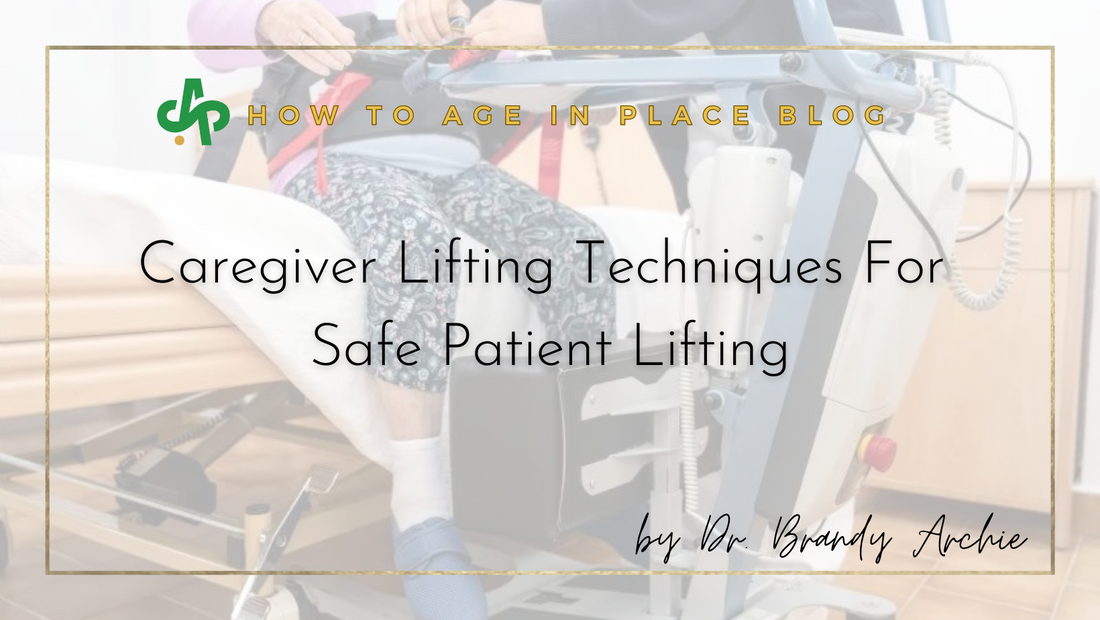Introduction
We often provide care out of duty, but it's a demanding role, requiring a balance of emotional strength and physical stamina. One of the most challenging tasks caregivers face is lifting and moving their care partner, which can strain the body and minds of both partners! Proper lifting techniques are essential for ensuring the safety of both the caregiver and the patient. Without these techniques, the risk of injury—such as back strains, muscle tears, or even more severe conditions—significantly increases. In my practice, I have seen how adopting the right techniques and tools not only improves the quality of care provided to patients but also maintains the caregiver's health, which is so key!
In this article, we'll look at ways to lift patients safely. We'll start with basic rules of safe lifting, then look at specific methods and tools that can make these tasks safer and easier. Whether you're lifting an older adult from a chair or helping someone move from place to place, these tips will help you get the job done well while protecting yourself.
Key Takeaways:
- Proper lifting techniques are vital to preventing injuries for both caregivers and care partners.
- Understanding the basics of ergonomics can make lifting safer and more efficient.
- Using specific patient lifting techniques, such as the squat pivot transfer or sliding board transfer, can help in different situations.
- Various tools, including patient lifts and transfer belts, can assist in safe patient handling.
- Consistent practice and attention to safety can enhance caregiver well-being and patient care.
Understanding Basic Lifting Principles
Fundamentals of Safe Lifting
Before diving into specific patient lifting techniques, it's crucial to understand the basic principles of safe lifting. These principles are grounded in ergonomics, a science dedicated to optimizing human performance by designing tasks, equipment, and workspaces that suit the user’s physical capabilities.
- Stable Base of Support: A stable base starts with your feet. Keep them shoulder-width apart, with one foot slightly ahead of the other. This stance helps distribute the person’s weight evenly across your body, reducing the risk of imbalance or strain.
- Spinal Alignment: Always keep your spine in a neutral position—neither too arched nor too rounded. Avoid twisting your back while lifting. Instead, pivot with your feet to turn, ensuring that your shoulders, hips, and feet move together.
- Assess Before Lifting: Before attempting to lift, assess the situation. Is the person alert and ready so they can help, too? What is their weight and mobility level? Is there enough space to perform the lift safely? Answering these questions will help you choose the most appropriate technique.
These fundamentals create a foundation that minimizes strain on your body and maximizes safety during patient lifting.
Techniques for Lifting Patients
Types of Patient Lifting Techniques
Every patient is unique, and so are their lifting needs. Whether you’re moving someone from a wheelchair to a bed or helping them stand up, there are specific patient lifting techniques designed to address different scenarios safely.
-
Squat Pivot Transfer: This technique is ideal for moving a patient from a wheelchair to a bed or chair. The squat pivot transfer minimizes the need for the patient to stand fully and reduces strain on both the caregiver and the patient.
- Step-by-Step Instructions for Wheelchair to Bed Transfer:
- Position the wheelchair at a slight angle to the bed, ensuring the wheels are locked.
- Ask the patient to scoot to the edge of the wheelchair and place their feet flat on the floor.
- Stand in front of the patient, placing your feet shoulder-width apart.
- Bend your knees into a squat position, keeping your back straight.
- Have the patient place their hands on the armrests of the wheelchair to help push.
- Grasp the patient’s waistband of their pants or use a transfer belt.
- On the count of three, help the patient push off the wheelchair while you pivot your body, transferring them to the bed or chair.
-
Sit-to-Stand Transfer: Assisting a patient from a seated to a standing position requires careful coordination. This technique is especially useful for patients who have some lower body strength but need support.
- Step-by-Step Instructions:
- Place the patient’s feet shoulder-width apart, directly under their knees.
- Encourage the patient to lean forward, shifting their weight onto their feet.
- Stand in front of the patient with your knees slightly bent and your back straight.
- Ask the patient to push off from the chair or bed with their hands while you help by lifting their torso.
- Guide them to a standing position, ensuring they are stable before releasing your support.
-
Sliding Board Transfer: This technique is useful for transferring patients with very limited mobility, such as those who are unable to bear weight on their legs. A sliding board acts as a bridge between the two surfaces, allowing the patient to slide across with minimal lifting.
- Step-by-Step Instructions:
- Position the wheelchair at a slight angle to the bed or chair, ensuring the wheels are locked.
- Place one end of the sliding board under the patient’s buttocks and the other end on the surface they are transferring to.
- Instruct the patient to place their hands on the board for support.
- Assist the patient by guiding their movements, helping them slide across the board from the wheelchair to the bed or chair.
- Once the patient is securely on the new surface, remove the sliding board carefully.
Each of these patient lifting techniques has its place, depending on the patient's specific needs and the caregiver's ability. The goal is always to minimize the physical strain on the caregiver while ensuring the patient's safety and comfort during the transfer.
Tools to Assist with Patient Lifting
Improving Safety with Lifting Aids
The physical demands of caregiving can be mitigated with the use of suitable lifting aids. These tools are designed to assist with safe patient handling, reducing the risk of injury and making the lifting process smoother for both the caregiver and the patient. Here are some essential tools to consider:

-
Portable Patient Lifts: These devices are invaluable when lifting patients
who are completely dependent. Portable patient lifts can be hydraulic or electric. They help raise and move patients from one place to another without much effort from the caregiver.
-
Transfer Belts: A transfer belt, also known as a gait belt,
provides a secure hold on the patient, giving the caregiver better control during transfers. Transfer belts are particularly useful during sit-to-stand lifts or when helping a patient walk short distances. Consider a padded transfer belt with easy-to-grip handles for added comfort and safety.

- Adjustable Beds: Adjustable beds can be raised or lowered, which makes patient transfers easier and reduces the need for excessive bending or lifting. They are particularly beneficial when moving patients from a lying to a sitting position. Adjustable beds at AskSAMIE include models with built-in side rails for additional safety.
Using these tools makes patient lifting safer and makes the caregiving experience better by making it easier for the caregiver.
Safety Tips for Home Caregivers
Lifting Techniques for Home Caregivers
Lifting patients at home can be challenging, especially without the support of additional healthcare professionals. However, by following these practical tips, caregivers can ensure safer and more effective patient handling:
- Clear the Clutter: Before lifting or moving a patient, make sure the pathway is free of obstacles. Clutter increases the risk of tripping or losing balance, which can be dangerous during a transfer.
- Training and Regular Practice: After you've learned how to do the transfer from a trained professional, consistent practice of lifting techniques can build muscle memory, making the process safer and more efficient over time. Practice also helps in identifying any adjustments that may be needed in the technique.
- Self-Care and Breaks: Caregivers must take care of themselves to provide the best care for others. Regular breaks, proper hydration, and stretching exercises can help prevent fatigue and reduce the risk of injury during patient lifting.
Incorporating these safety tips into your daily routine can make a significant difference in your ability to care for your patient while maintaining your own health and well-being.
Frequently Asked Questions
In summary, let's review some of our frequently asked questions real quick right here.
What are the best patient lifting techniques for caregivers?
- The best patient lifting techniques include the squat pivot transfer, sit-to-stand transfer, and sliding board transfer. These methods minimize strain on the caregiver and ensure the patient's safety. Always maintain a stable base, use your legs to lift, and avoid twisting your back to prevent injuries.
How to use a sliding board for patient transfers?
- To use a sliding board, position the wheelchair at an angle to the destination, lock the wheels, and place one end of the board under the patient’s buttocks. The other end should rest on the destination surface. Guide the person as they slide across, using their hands for support. Remove the board once the transfer is complete.
What tools can help caregivers lift patients safely?
- Essential tools for safe patient lifting include portable patient lifts, which use hydraulic or electric mechanisms for easy transfers, and transfer belts, which provide a secure grip during movement. Adjustable beds help reduce bending and lifting strain. These aids improve safety and reduce caregiver injury risks.
How can caregivers prevent injuries while lifting patients?
- Caregivers can prevent injuries by using proper lifting techniques: keep a stable base, align the spine, and lift with the legs, not the back. Assess the situation before lifting and use tools like transfer belts and patient lifts. Regular practice and taking breaks help maintain physical health and prevent strain.
Ergonomic principles for safe patient handling.
- Ergonomic principles for safe patient handling include maintaining a neutral spine, avoiding twisting, and keeping a stable base of support. Use tools like transfer belts and lifts to reduce physical strain. Always assess the patient’s mobility and weight before lifting, and use proper techniques to minimize injury risks.
Conclusion
The importance of using correct lifting techniques cannot be overstated. By adopting safe patient lifting methods, caregivers can significantly reduce the risk of injury to themselves and their patients. As a caregiver, it’s essential to continue learning and practicing these techniques, and to seek help or training if needed.
If you’re looking for more support, reach out to AskSAMIE for assistance from licensed occupational therapists who can provide personalized advice and training on caregiver lifting techniques. Consider signing up for a training session to improve your skills and ensure the safety of both you and your patient.
Remember, your well-being is just as important as the care you provide.



